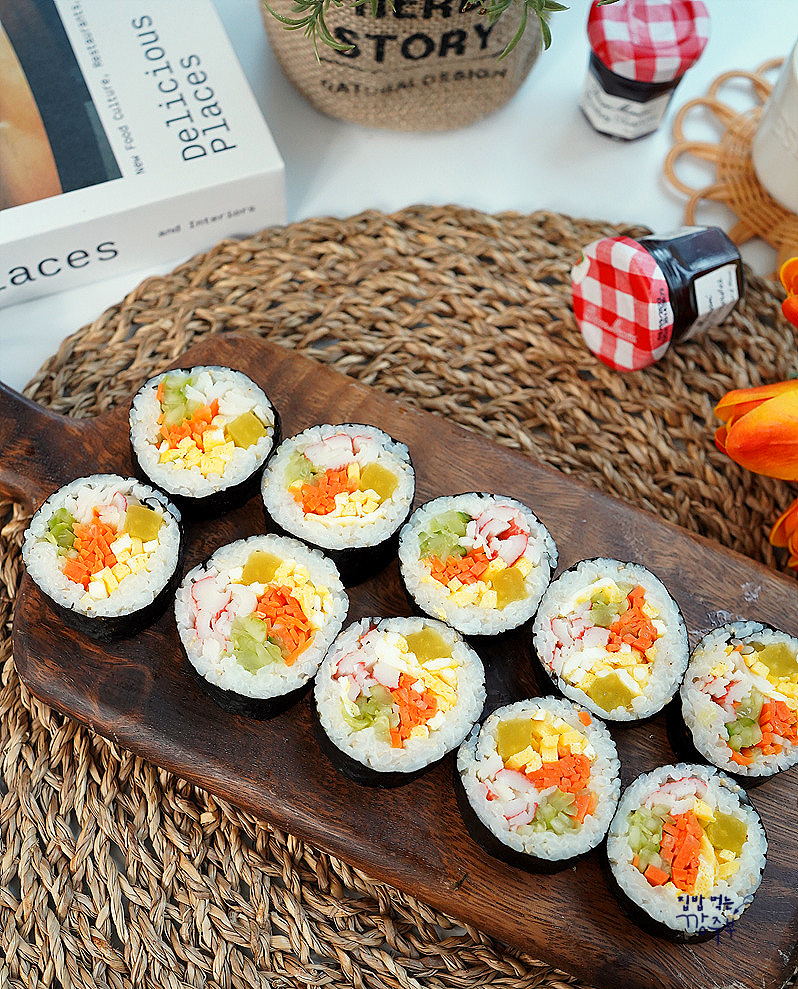Crisp and Refreshing Salad Kimbap
Simple and Light Salad Kimbap Using Ingredients You Already Have!

Introducing a simple and refreshing salad kimbap recipe that’s light and perfect for a healthy meal, made with ingredients you likely have at home! While it omits ham, it includes all the fundamental kimbap fillings. For an even more delicious experience, feel free to increase the amount of your favorite vegetables. This kimbap is so tasty that even kids will ask for more! Enjoy the delightful crunch of finely julienned vegetables in this crab stick salad kimbap recipe.
Ingredients- 3 sheets of dried seaweed (gim) for kimbap
- 2.5 bowls of cooked rice
- 2 cucumbers
- 1 carrot
- Generous amount of imitation crab sticks (like surimi)
- 3-4 eggs
- Pinch of salt
- Pinch of cooking oil
Rice Seasoning- Pinch of salt (seasoned)
- Teaspoon of sesame oil
- Teaspoon of toasted sesame seeds
- Pinch of salt (seasoned)
- Teaspoon of sesame oil
- Teaspoon of toasted sesame seeds
Cooking Instructions
Step 1
Thoroughly wash the cucumbers, then partially peel them using a peeler, leaving some peel on for visual appeal and texture. Rubbing with coarse salt can help remove residual pesticides and bitterness from the peel.

Step 2
Partially peel the cucumbers with a peeler. Leaving some peel on makes them look more appealing and adds to the texture. You can peel them completely or leave them as is, depending on your preference.

Step 3
Julienne the prepared cucumbers thinly using a mandoline slicer or a knife. A mandoline is best for uniform, thin strips, but be cautious when using it.

Step 4
Place the julienned cucumbers in a bowl, sprinkle with 3 pinches of salt, and let them sit for 10 minutes to draw out moisture. Squeeze out the excess water thoroughly using a clean cloth or paper towel. This step is crucial to prevent the kimbap from becoming soggy.

Step 5
Wash the carrot thoroughly, peel its outer skin, and then julienne it thinly.

Step 6
Heat a sufficient amount of cooking oil in a frying pan. Add the julienned carrots and a pinch of salt, then stir-fry until they are softened. Ensure the carrots are cooked through but not mushy.

Step 7
Shred the imitation crab sticks with your hands. For an added flavor boost, you can mix them with a little mayonnaise and wasabi before adding them to the kimbap.

Step 8
Crack 3-4 eggs into a large bowl. Lightly whisk them, removing the chalazae (the white stringy bits), and add 2 pinches of salt. Whisk well to ensure a smooth, evenly colored omelet.

Step 9
Lightly grease a frying pan with cooking oil and pour in the beaten egg mixture over low heat to cook a thin omelet. Cooking slowly over low heat prevents burning and ensures even cooking.

Step 10
Once the omelet is golden brown on both sides, transfer it to a plate and let it cool completely. Cutting a warm omelet can cause it to break apart easily, so ensure it’s fully cooled before slicing.

Step 11
Once cooled, roll up the omelet tightly and slice it thinly. Thin slices will fit neatly within the kimbap.

Step 12
Season the cooked rice with seasoned salt, sesame oil, and toasted sesame seeds. Mix thoroughly to distribute the seasoning evenly and prevent clumps of salt.

Step 13
All the ingredients for your salad kimbap (stir-fried carrots, shredded crab sticks, squeezed cucumbers, and sliced omelet) are now ready. It’s time to roll them into beautiful kimbap rolls!

Step 14
Lay a sheet of plastic wrap on a bamboo rolling mat. Place a sheet of kimbap seaweed (gim) on top, with the rough side facing up. This method helps keep the bamboo mat clean and makes for a tidy finish.

Step 15
Spread the seasoned rice thinly over the seaweed, leaving a small border at the top. Adjust the amount of rice to your preference; too much rice can make rolling difficult. Modern kimbap often features less rice and more filling, so aim for a thin layer of rice.

Step 16
Arrange the prepared ingredients evenly over the rice. Don’t overfill, as this can cause the kimbap to burst when rolling or slicing. Ensure there’s a slight overlap of rice at the edge to help seal the roll. When rolling, gently but firmly press the fillings to keep them in place and create a compact roll. The key is to keep the fillings from shifting.

Step 17
Use the bamboo mat to tightly roll the kimbap, pressing firmly to shape it securely.

Step 18
Brush the outside of the rolled kimbap with sesame oil and sprinkle with toasted sesame seeds for a glossy finish and added flavor.

Step 19
Kimbap is best sliced with a sharp knife to ensure clean, beautiful cuts. A dull knife will tear the seaweed and ruin the appearance. Carefully slice the kimbap using a sharp blade for a perfect presentation.




